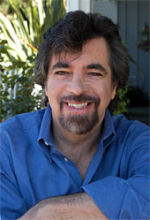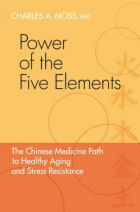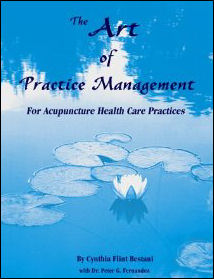Acupuncture & TCM Articles

Neil R. Gumenick is the founder and Director of The Institute of Classical Five-Element Acupuncture. Neil is a Worsley certified advanced teacher of Classical Five-Element Acupuncture and a practitioner with over 27 years of private practice experience. Neil holds three degrees from the College of Traditional Acupuncture (U.K.), and he participated for 10 years in the Master Apprentice Programô, led by Profs. J.R. & J.B. Worsley. Neil has taught at the USC and UCLA Schools of Medicine, the Worsley Institute of Classical Acupuncture, the Traditional Acupuncture Foundation, California Acupuncture College, Santa Barbara College of Oriental Medicine, and Pacific College of Oriental Medicine. He has been a Professor at Emperor's College of Traditional Oriental Medicine and SAMRA University of Oriental Medicine. Neil is co-author of The Art of Practice Management for Acupuncture Health Care Practices
The Spirit of the Water Element: Why weren't we taught this in school?
by Neil R. Gumenick
The word "terrorism" reminds us of how vital the Water Element is to the mind and spirit, to life itself. Without a supply of water, nothing can sprout and grow in spring, flower and blossom in summer, and ultimately be harvested in late summer. We can understand the correspondence of the emotion fear to this element. With no harvest in sight, the future itself is unknown and uncertain. With no reserves, our very survival is in doubt; the end may come at any time and without warning.
 
On a daily basis, we may worry over relatively trivial things, but when our survival is threatened, we feel the depth of fear that arises from the Water Element in imbalance. For many of us, such a fear became real and palpable with the terrorist attacks of 9/11/01. The threat of further random destruction, chemical and biological warfare, loss of livelihood, in which anyone could be a victim at any time, with no end in sight, is a fear so enormous as to be almost inconceivable. We all see patients whose imbalances at the level of the spirit have filled them with such fear virtually all of their lives.
People who farm the land know that water must be conserved and stored during the rainy season to irrigate the crops, to drink, and to cleanse. If there is insufficient water in reserve during the dry season, not only will the crops perish in the heat, but the whole irrigation system of canals and ditches will become stagnant and polluted without the cleansing flow of water to carry away dead and rotting waste.
It is the same within our bodies. We are, physically, three quarters fluid. Everything that nourishes, protects, lubricates, grows, eliminates, or otherwise moves within us, does so by the grace of the Water Element. As it is for the body, water is equally important for the mind and spirit. Without the cleansing flow of the Water Element, the mind loses its flexibility, its ease of retrieving data from the storehouse of memory, its ability to clean itself of old negativity and habituated patterns, to adapt and take a new shape.
One of the gifts of the Water Element is its ability to find a passage around any obstruction, to take the shape of whatever contains it, to fill every hollow and yield to every protrusion. For us, this is the ability to respond with absolute precision and appropriateness to any and every situation. Water gives us the ability to be internally quiet: to "listen," not just with our physical ears, but with our mind and spirit. When this element is healthy, we respond to life neither by running away (excess fear) nor by reckless attacking (lack of fear). Neither extreme is appropriate or realistic. Both are expressions of imbalance.
Behaviorally, some with a water imbalance may nervously babble, their bodies fidgeting and tense, unable to relax, in a constant adrenaline rush. Some will run themselves ragged, distracting themselves from their fear or crazily looking for external solutions that seem to offer reassurance (i.e.: "If only I had this or that, then I could relax"). Others simply go blank, petrified, unable to move forward either in body or mind. At the spirit level, people can become stuck in shock, numb, or frozen with fear. It is as if the inner reservoir has been broken, either by an overwhelming trauma or a gradual wearing away and depletion, and the flow of life has virtually ceased. The very core of a person's self identity and survival has been shaken so that, to some degree, every encounter or situation is frightening. With insufficient reserves or with the flow and purity of water compromised, there is simply not enough "cushion" in life, nothing in the "bank" on which to draw. Often, this can be detected in the eyes, which is colloquially likened to the eyes of a "deer caught in the headlights."
To a great degree, we can tax and abuse our reserves by our own lifestyles to the point that we are left utterly exhausted. Like a farmer who does not conserve and store water when it is plentiful, the work ethic of the 20th century, "burning the candle at both ends" in an unquenchable thirst for material gain, leaves many of us and our patients depleted on all levels. Add to this the price paid for our massive cultural caffeine addiction, abuse of other recreational and prescription drugs, sexual excesses, and there is little wonder that patients arrive at our doors with labels like "chronic fatigue." Here, we must give our patients appropriate homework: realistic lifestyle changes, which properly place responsibility for healing on the patient as an active participant in the process. We must remember, too, that as water is the medium of every cell and system in the body, a water imbalance can create symptoms everywhere and anywhere.
The gift of the Water Element, when healthy, is that it grants us the ability and resolve to go on through the darkest and most trying of times. While the element evokes images of a quiet pool, reflecting reality without distortion, a resting place of recharging ourselves, it also brings to mind the relentless force of oceans, pounding away at rocky cliffs, slowly pulverizing them into sand; the depths of the Grand Canyon, formed by the patient wearing down of rock by flowing water.
Throughout history, the most inspiring tales of courage and heroism speak of the undefeatable human will from which people have found the inner strength to pick up the pieces, rebuild, and move forward in victory. Many of the acupuncture points with the most profound spiritual connotations for resurrection and renewal are found on the meridians of the Water Element.
Without the will and determination to survive, many patients cannot and will not recover, regardless of the name or category of their illness - regardless of how well we, as practitioners, have identified and treated the presenting syndrome. Without resurrecting or, as needed, rebuilding the mind and spirit, we are, at best, palliating the surface - putting a coat of paint on the outside of the house when there is a devastating sickness within. When the mind and spirit have been traumatized, it matters little that the body carries on, for it, too, must eventually falter. Used properly, there is no better system of medicine in the world than Classical Acupuncture to heal the mind and spirit.
When I teach Classical Five-Element Acupuncture and arrive at this juncture, the questions invariably arise, "Why weren't we taught about this in school? Why isn't this in the books, modern or classic?" The answers would themselves fill a book and one that I recommend for its historical account and perspective is called In the Footsteps of the Yellow Emperor: Tracing the History of Traditional Acupuncture by Peter Eckman, M.D. My short answers follow. by Peter Eckman, M.D. My short answers follow.
In the last fifty-plus years since the Communist takeover in China, the mental and spiritual components of the medicine have largely been eliminated. With its Marxist dialectical materialistic view of the world which places emphasis on the way in which things conflict and change with each other, phenomena is only recognized insofar as tangible (or measurable, quantifiable) effects are produced. This excludes the spiritual realm almost entirely and, thus, excludes consideration of how to treat it. Therefore, TCM, as it is has been taught, practiced, and exported to the West in the last half century, is oriented predominantly to the physical level only. Certainly, the concepts of healing the mind and spirit were known from antiquity in China, as evidenced in the point names (i.e. Spirit Gate, Spirit Hall, Spirit Burial Ground, Spirit Storehouse, Spirit Deficiency, etc.) translated from the Chinese, which indicated the quality of need each point was capable of fulfilling.
Secondly, we cannot learn to treat at the level of the mind and spirit from a book. We cannot interpret the needs of a patient at those levels, except in the presence of the patient in need. We cannot develop and refine our diagnostic senses of seeing, hearing, feeling, asking, and smelling from a book. We cannot diagnose a hypothetical patient from a printed page.
There is no prescribed treatment for "fear," for "depression," for "anger," or any other emotional label. There is only a unique individual whose experience of suffering is unique to him or her. We must diagnose the cause in this individual and determine exactly what the mind and/or spirit needs in order to heal. Therefore, though books are helpful in providing a framework, this system of medicine called Classical Five-Element Acupuncture must be a living, oral transmission.
Additionally, there is no such thing as a "water type", "earth type", or any other elemental "type", as there are, within any element, countless variations possible. Consider the element water and the myriad possibilities of its expression in Nature. There is water as vapor: steam; there is the fragile trickle of a stream, a mirror-like clear lake, a frozen glacier, the tumult of a raging sea. These present entirely differently, yet they are all water. It is no different in human beings. We can only know the individual who is before us through our own senses.
We cannot rely on tricks or shortcuts, such as elemental checklists, in which a person chooses statements from a personality profile that he feels are applicable to him. With such a method, we come away with a diagnosis about as useful and accurate as blindly picking slips of paper from a hat! This is an attempt to "symtomatize" the five elements into neat little categories and treat accordingly. In actual fact, any symptom can be the result of imbalance in any element or organ/function. Also, as we have seen, there are countless expressions of water as well as any other element. Two people with the same primary elemental imbalance (which we call the Causative Factor) can present as differently as night and day. What will confirm the elemental imbalance is the color in particular areas of the face, the sound of the voice, the emotional expression, and the odor.
A primary imbalance in the Water Element will manifest the color blue, the sound of groaning, the emotion of fear or lack of fear, and the putrid odor, but there are no two shades of blue the same, nor two groans, two expressions of fear, two putrid odors the same. Each element contains within it varying degrees of all five elements. The primary imbalance affects, and is affected by all, making for a unique expression in every person. Accurate diagnosis is challenging enough for the practitioner, an objective observer (though it can be learned). How much more farfetched to suggest that one can objectively self-diagnose through the skewed filter of one's own imbalance!
For many years, my teacher, Professor J.R. Worsley, did not discuss where or from whom he had learned Classical Five-Element Acupuncture, admonishing us that Nature itself is our best teacher. Although correct teaching and guidance is essential, he affirmed, it was up to us to work on ourselves in order to become worthy instruments of the healing force. "There is no magic pill or thunderbolt from the heavens after which you will suddenly 'get it'," he told me over 20 years ago, "but if you put in your time and effort, there is nothing that I have achieved that you cannot." Despite the presence of "rocky cliffs" in the form of setbacks, challenges, and hardships, we have both continued to grow. As I write this article in a bookstore in Santa Barbara, I note a man's T-Shirt as he he passes by. On the front, the question, "How do you get to Carnegie Hall?" On the back, the answer, "Practice, practice."
As published in the California Journal of Oriental Medicine, Winter 2001 issue
Professor Neil R. Gumenick is Founder and Director of the Institute of Classical Five-Element Acupuncture, which offers approved Continuing Education in this unique system of medicine. He holds three degrees and an advanced teaching credential from the College of Traditional Acupuncture (U.K.) awarded by Professor J.R. Worsley, with whom he personally studies to this day. Neil has maintained a private practice for 22 years in Santa Monica, CA and has been a Professor at Emperor's College and SAMRA University.
Book References
In the Footsteps of the Yellow Emperor: Tracing the History of Traditional Acupuncture by Peter Eckman, M.D. by Peter Eckman, M.D.
 
The Art of Practice Management for Acupuncture Health Care Practices
What you will find in this book is a specific, comprehensive approach that gets to the root cause of success in practice.
This new book presents acupuncture practice as art from the standpoint of centering, qi, and wholeness. It builds on the premise that practices succeed from bridging inner and outer aspects of the self. It is an inquiry into the self and addresses clear understandings and approaches to reputable patient care and practice qi. It brings in the five elements and work with the seasons of practice from training and start-up to growth, stability, expansion and transformation. The authors artfully bridges the essence of both patient and practitioner well-being without excluding the practicalities of financial well-being. This book very specifically and extensively shows how the different parts of practice nourish and feed one another and are interdependent on one another for the qi to flow synchronistically.
It explores the dual nature of procedures that work and those which do not in acupuncture health care practice, returning again and again to the delicate balance of practicality and spirituality.
|
